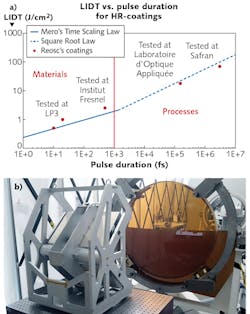Laser Optics: Meter-class, high-LIDT optics meet petawatt, ultrafast requirements

Since 1937, Safran Reosc (Saint Pierre du Perray, France) has been developing high-performance optical coatings and optomechanical laser systems to deliver ultrashort-pulsed (ultrafast) laser beams for petawatt-power class lasers such as the APOLLON 10P in France, PETAL, and the multi-national Extreme Light Infrastructure (ELI) project.
In addition to broad spectral bandwidth, petawatt-class coatings must have very high reflectivity across the entire wavelength range, very low dispersion, and very high damage threshold—1 J/cm2 fluence values with 20 fs pulse duration, for example, are not uncommon now. Recognizing that the availability of such large high-power optics remains the limiting factor for increasing laser peak power on today's lasers, Safran Reosc embarked on a three-year R&D program to develop the world's highest laser-induced damage threshold (LIDT) broadband femtosecond coating for APOLLON 10P in close collaboration with the Laboratoire d'Optique Appliquée (LOA; Palaiseau, France) and Institut Fresnel (Marseille, France).1
To reach 10 PW peak power with illumination intensity of 1022 W/cm2 and higher for the APOLLON 10P laser, multilayer dielectric coatings need to withstand energies over a broad spectral range, as dictated by the chirp-pulse amplification (CPA) methods that allow the creation of such ultrashort pulses in the first place. Acal BFi (Lisses, France) is now commercializing custom optics and coatings from Safran Reosc that increase the spectral bandwidth of petawatt-class coatings by 50% while maintaining high reflectivity and high damage-threshold performance.
Optimizing high-LIDT materials
In the femtosecond regime, damage mechanisms are driven by electronic processes and not just thermal effects. To improve the coating performance for APOLLON 10P, Safran Reosc engineers studied the LIDT of electron-beam deposited (EBD) dielectric materials to increase the laser resistance of broadband high reflective (HR) and low dispersive stacks.
Because the spectral specifications for petawatt mirrors cannot be reached by classical high laser-resistant quarter-wave silicon dioxide/hafnium oxide (SiO2∕HfO2) stacks, other oxides of aluminum, yttrium, scandium, titanium, and tantalum were explored as possible dielectric materials.
Single-layer (SL) and HR-multilayers for s-polarization (S-HR) or p-polarization (P-HR) were deposited on fused-silica substrates cleaned with a specific laser procedure and irradiated by a number of different lasers with different wavelength, fluence, and pulse shape. Tests on SL samples showed that LIDT decreases with the increase of the refractive index and linearly increases with the bandgap.
Theoretical and experimental validation of LIDT vs. electric field intensity (EFI) of materials in the stack allowed Safran Reosc to optimize high reflective and low dispersion broadband designs according to petawatt system requirements, resulting in a hybrid thin film design called Metal-Multi Layer Dielectric (MMLD)—a unique coating now being used for beam transport in APOLLON 10P, from folding mirrors to 90° off-axis focusing parabolas. Over a 200 nm spectral range, at 45° of incidence in both s- and p-polarization, the coating has a reflectivity above 99% and a peak-to-peak variation of the group delay dispersion (GDD) below 100 fs2.
In addition, the coatings have at least 2X better LIDT than any other vendors for similar bandwidth and are tested even after the coating is applied using a large-diameter interferometer (see figure).
"At the beginning of my PhD studies—at Safran Reosc, LOA, and Institut Fresnel—there were no laser coatings available on the market answering the requirements of APOLLON 10P," says Adrien Hervy, Safran Reosc Coating workshop manager. "Now, we have manufactured, in our 1.7 m coating chamber, more than 50 large optics with our low-stress MMLD coating, and we have started to export it."
REFERENCE
1. A. Hervy et al., SPIE Opt. Eng., 56, 1, 011001 (2016).

Gail Overton | Senior Editor (2004-2020)
Gail has more than 30 years of engineering, marketing, product management, and editorial experience in the photonics and optical communications industry. Before joining the staff at Laser Focus World in 2004, she held many product management and product marketing roles in the fiber-optics industry, most notably at Hughes (El Segundo, CA), GTE Labs (Waltham, MA), Corning (Corning, NY), Photon Kinetics (Beaverton, OR), and Newport Corporation (Irvine, CA). During her marketing career, Gail published articles in WDM Solutions and Sensors magazine and traveled internationally to conduct product and sales training. Gail received her BS degree in physics, with an emphasis in optics, from San Diego State University in San Diego, CA in May 1986.